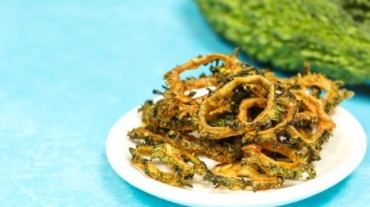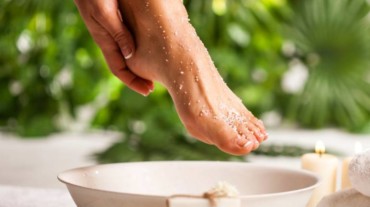
Karela! It’s one of those vegetables which easily makes me scrunch my nose in disgust. The bitter taste is to blame. But let me admit, I’ve sort of graduated to having a bittersweet bond with bitter gourd ever since it started showing a positive impact on my diabetic mother’s sugar levels.

Yes, we’ve heard about the health wonders of karela – whether it is by consuming it in the form of juice, a spicy sabzi, bharwan or fried (not so healthy!). But this – watching my mom dip her feet into the dark green juice – and reaping benefits, was new to me.
She told me that this unique suggestion came from our househelp. It piqued my curious mind. On being asked where she had come across this, she recounted reading about this ‘nuskha’ in a book on natural remedies that my dadi used to refer to.
While my mom doesn’t mind karela in her diet, I thought this ‘karela pedicure’ (just kidding!) is a go-to for people like me for whom the bitter gourd is a no-no. But here’s a little catch – you have to dip your feet in the water for around 30 minutes, till the taste of karela reaches your mouth. Yes, it happens, my mom told me from her experience.

A quick online search led me to discussion forums where people raised doubts on the efficiency of this “strange” method as a “ploy”. Some were concerned about whether foot-soaking is the right solution for diabetic feet.
As for my mother, she said that 10 days of soaking her feet in karela juice led to a marginal reduction of sugar levels. Her sugar levels dropped from 160 to 130. She ensured that her feet were properly cleaned and dried afterwards.
The juice of bitter gourd is beneficial for diabetes management if a patient consumes it orally, Dr Avinash Kumbhar, Consultant General Medicine, Aster Aadhar Hospital, told HealthShots.
What about dipping feet in it?
“Scientifically it has not been validated to have the similar benefits after dipping feet in karela juice. It has been proven that regular exercise, good diet, proper sleep, sugar control with help of medication and concrete lifestyle changes can help in management of diabetes as we observe in millions of patients worldwide,” Kumbhar explained.
Also Read: Does karela juice make you go UGH? Try these ways to make it more delectable
Select Topics of your interest and let us customize your feed.
PERSONALISE NOW
Nutritionist Aakriti Arora gave us a lowdown on how the nutrients and benefits of the bitter gourd can truly sweeten our lives.
“Our humble karela is rich in antioxidants like catechin, gallic acid, epicatechin and chlorogenic acid. It also boasts a huge reserve of vitamin A and vitamin C and minerals like potassium, folate, zinc and iron; all while being loaded with healthy fats and proteins,” Arora told HealthShots.
Karela contains three active substances – polypeptide, vicine and charanti – that have anti-diabetic effects. These have been confirmed to have insulin-like properties and blood sugar-lowering effects.
Lectin, found in bitter gourd, helps to reduce blood glucose concentrations in the body, acting on the peripheral tissues. As per experts, lectin is responsible for triggering the hypoglycemic effect, which basically means lowering the blood sugar levels in the body.
Also Read: Your ready to use guide on dos and don’ts of type 2 diabetes
Get Latest Updates on Healthy Eating, Nutrition, Recipes, Superfoods